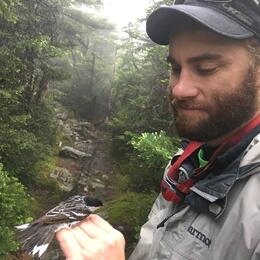In Vermont, we are fortunate to live in the largest temperate broadleaf forest on the planet. Our forests are critical to the character of our state, the health of our ecosystem, and our livelihoods. Forests offer unparalleled services- they manage and filter water, provide fresh air, sequester and store carbon, and are home to a diversity of plants and animals that are altogether vital components of our ecosystem. They offer renewable resources that sustain us. Yet, the diversity of Vermont’s forests are not as great as they once were; they continue to rebound from wide-scale deforestation of the 19th century. As forests grow back, and our contemporary understanding of forest ecology evolves, so must our ability to readily measure, and from this point, improve, the health of the forest across the landscape. Thankfully, as one strategy, we can look to the birds to offer both a measure and means to improve ecosystem health and overall biodiversity of Vermont’s Forests.
Vermont’s forests serve as core breeding habitat for over 40 species of birds, including many resident and neotropical songbirds, upland game birds, woodpeckers, hawks, owls, and even a few waterfowl. Among all these species, their individual habitat needs (i.e. requirements for food, water, shelter, space and assembly) vary; to make it simple, Audubon Vermont has selected 12 species, those we call our ‘Birders Dozen’, that together capture the basic habitat needs of our forest birds.
By looking at the bird species that together occupy a forest, we can infer the quality of the habitat that is there- a reflection of the diversity and health of the ecosystem. Conversely, by identifying and managing our forests towards the diversity of conditions that birds need in order to thrive, we can also improve forest ecosystem health through our stewardship efforts. Moreover, birds offer a tangible and compelling reason for many people to engage in forest stewardship. Together, these concepts underpin the foundational and hugely successful Foresters for the Birds project, a collaboration between Audubon Vermont and the Vermont Department of Forests, Parks, and Recreation.
Audubon Vermont developed the first-of-its-kind program in the nation focused on providing technical assistance and education to foresters, resource managers, and landowners regarding strategies for improving forest bird habitat through the means of active forest stewardship, including timber management. The seminal publications Silviculture with Birds in Mind and Birds with Silviculture in Mind offer strategies for both landowners and land managers with which to help restore habitat diversity to Vermont forests through management. Today, various forms of the original Foresters for the Birds program can be found in dozens of states across the nation.
The concepts underlying bird friendly silviculture involve, first and foremost, keeping forests as forest, and from there, maintaining a diversity of forest conditions at various scales. This involves maintaining a landscape containing a mosaic of forests of various ages and developmental stages, including upland habitat, riparian areas, and forest wetlands in the mix; promoting diversity in terms of assembly of stands comprised of different tree species of different ages; improving complex vertical structure within the forest across understory, midstory, and overstory; and maintaining the presence of hard and soft mast-bearing plants, large-diameter (legacy) trees, standing dead trees, cavity trees, and coarse and fine woody material on the forest floor. All while working to keep invasive plants, pests, and pathogens out of forests. In essence, through active stewardship, including timber harvest, we are trying to support, and emulate, the natural processes that result in forest diversity of benefit to birds and the greater ecosystem.
Through the Woods, Wildlife, and Warblers program, Audubon Vermont offers free 1:1 technical assistance to landowners interested in managing their forests for birds. We meet with landowners on their property to tour their lands, offering personalized experiences exploring their bird community, talking about forest ecology, and discussing their land stewardship values and plans. We offer written reports of our findings catered to each landowner’s unique situation, alongside current information on strategies to increase climate resiliency and support forest carbon dynamics. This summer, we delivered this service to 17 landowners owning over 3000 acres of forests. To date, Audubon has worked 1:1 with over 130 landowners stewarding nearly 33,000 acres across Vermont.
Critical to the success of these efforts is collaboration among landowners and our conservation partners across the state, including the professional forester community- those writing the forest management plans for landowners. Currently, Audubon is piloting a Forester Training and Endorsement program that we hope will meet the growing demand among landowners for managing their forests for birds and the greater biodiversity that comes with them.
Learn more about Audubon Vermont’s Healthy Forest programs, including resources with which to approach forest stewardship through the lens of birds here.




